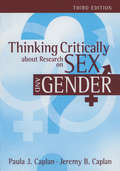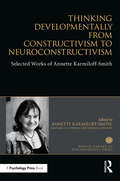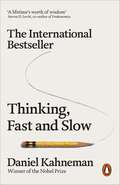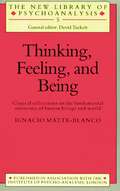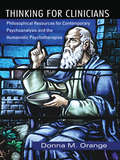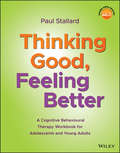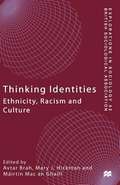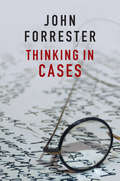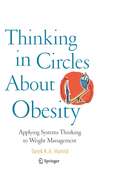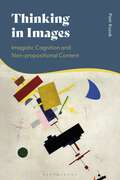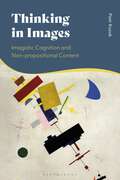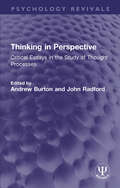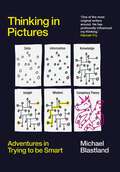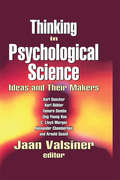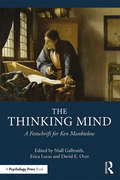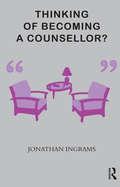- Table View
- List View
Thinking Critically about Research on Sex and Gender
by Jeremy Caplan Paula J CaplanThe authors first demonstrate that most of the claims about sex and gender are not well supported by research, and then provide readers with constructive critical tools they can apply to this wealth of research to come to realistic, constructive conclusions. All of this is provided in a concise, inexpensive volume by a best-selling trade author and instructor team.
Thinking Developmentally from Constructivism to Neuroconstructivism: Selected Works of Annette Karmiloff-Smith (World Library of Psychologists)
by Annette Karmiloff-Smith Michael S. Thomas Mark H JohnsonIn the World Library of Psychologists series, international experts present career-long collections of what they judge to be their finest pieces - extracts from books, key articles, salient research findings, and their major practical theoretical contributions. This influential volume of papers, chosen by Professor Annette Karmiloff-Smith before she passed away, recognises her major contribution to the field of developmental psychology. Published over a 40-year period, the papers included here address the major themes that permeate through Annette’s work: from typical to atypical development, genetics and computation modelling approaches, and neuroimaging of the developing brain. A newly written introduction by Michael S. C. Thomas and Mark H. Johnson gives an overview of her research journey and contextualises her selection of papers in relation to changes in the field over time. Thinking Developmentally from Constructivism to Neuroconstructivism: Selected Works of Annette Karmiloff-Smith is of great interest to researchers and postgraduates in child development specialising in atypical development, developmental disorders, and developmental neuroscience. It also has appeal to clinical neuropsychologists and rehabilitation professionals.
Thinking Developmentally from Constructivism to Neuroconstructivism: Selected Works of Annette Karmiloff-Smith (World Library of Psychologists)
by Annette Karmiloff-Smith Michael S. Thomas Mark H JohnsonIn the World Library of Psychologists series, international experts present career-long collections of what they judge to be their finest pieces - extracts from books, key articles, salient research findings, and their major practical theoretical contributions. This influential volume of papers, chosen by Professor Annette Karmiloff-Smith before she passed away, recognises her major contribution to the field of developmental psychology. Published over a 40-year period, the papers included here address the major themes that permeate through Annette’s work: from typical to atypical development, genetics and computation modelling approaches, and neuroimaging of the developing brain. A newly written introduction by Michael S. C. Thomas and Mark H. Johnson gives an overview of her research journey and contextualises her selection of papers in relation to changes in the field over time. Thinking Developmentally from Constructivism to Neuroconstructivism: Selected Works of Annette Karmiloff-Smith is of great interest to researchers and postgraduates in child development specialising in atypical development, developmental disorders, and developmental neuroscience. It also has appeal to clinical neuropsychologists and rehabilitation professionals.
Thinking, Fast and Slow
by Daniel KahnemanThe phenomenal international bestseller - 2 million copies sold - that will change the way you make decisions'A lifetime's worth of wisdom' Steven D. Levitt, co-author of Freakonomics'There have been many good books on human rationality and irrationality, but only one masterpiece. That masterpiece is Thinking, Fast and Slow' Financial TimesWhy is there more chance we'll believe something if it's in a bold type face? Why are judges more likely to deny parole before lunch? Why do we assume a good-looking person will be more competent? The answer lies in the two ways we make choices: fast, intuitive thinking, and slow, rational thinking. This book reveals how our minds are tripped up by error and prejudice (even when we think we are being logical), and gives you practical techniques for slower, smarter thinking. It will enable to you make better decisions at work, at home, and in everything you do.
Thinking, Feeling, and Being: Clinical Reflections On The Fundamental Antinomy Of Human Beings And World (The New Library of Psychoanalysis #Vol. 5)
by Ignacio Matte-BlancoIgnacio Matte-Blanco has made one of the most original contributions to psychoanalysis since Freud. In this book, which includes an introductory chapter to his work by Eric Rayner and David Tuckett, he develops his conceptualization of the Freudian unconscious in terms of logic and mathematics, giving many clinical examples.
Thinking, Feeling, and Being (The New Library of Psychoanalysis)
by Ignacio Matte-BlancoIgnacio Matte-Blanco has made one of the most original contributions to psychoanalysis since Freud. In this book, which includes an introductory chapter to his work by Eric Rayner and David Tuckett, he develops his conceptualization of the Freudian unconscious in terms of logic and mathematics, giving many clinical examples.
Thinking for Clinicians: Philosophical Resources for Contemporary Psychoanalysis and the Humanistic Psychotherapies
by Donna M. OrangeThinking for Clinicians provides analysts of all orientations with the tools and context for working critically within psychoanalytic theory and practice. It does this through detailed chapters on some of the philosophers whose work is especially relevant for contemporary theory and clinical writing: Emmanuel Levinas, Martin Buber, Ludwig Wittgenstein, Maurice Merleau-Ponty, and Hans-Georg Gadamer. Orange presents the historical background for their ideas, along with clinical vignettes to help contextualize their theories, further grounding them in real-world experience. With a hermeneutic sensibility firmly in mind, Thinking for Clinicians rewards as it challenges and will be a valuable reference for clinicians who seek a better understanding of the philosophical bases of contemporary psychoanalytic theory.
Thinking for Clinicians: Philosophical Resources for Contemporary Psychoanalysis and the Humanistic Psychotherapies
by Donna M. OrangeThinking for Clinicians provides analysts of all orientations with the tools and context for working critically within psychoanalytic theory and practice. It does this through detailed chapters on some of the philosophers whose work is especially relevant for contemporary theory and clinical writing: Emmanuel Levinas, Martin Buber, Ludwig Wittgenstein, Maurice Merleau-Ponty, and Hans-Georg Gadamer. Orange presents the historical background for their ideas, along with clinical vignettes to help contextualize their theories, further grounding them in real-world experience. With a hermeneutic sensibility firmly in mind, Thinking for Clinicians rewards as it challenges and will be a valuable reference for clinicians who seek a better understanding of the philosophical bases of contemporary psychoanalytic theory.
Thinking Good, Feeling Better: A Cognitive Behavioural Therapy Workbook for Adolescents and Young Adults
by Paul StallardInstructional resource for mental health clinicians on using cognitive behavioural therapy with adolescents and young adults This book complements author Paul Stallard’s Think Good, Feel Good and provides a range of Cognitive Behaviour Therapy resources that can be used with adolescents and young adults. Building upon that book’s core strengths, it provides psycho-educational materials specifically designed for adolescents and young people. The materials, which have been used in the author’s clinical practice, can also be utilized in schools to help adolescents develop better cognitive, emotional and behavioural skills. Thinking Good, Feeling Better includes traditional CBT ideas and also draws on ideas from the third wave approaches of mindfulness, compassion focused therapy and acceptance and commitment therapy. It includes practical exercises and worksheets that can be used to introduce and develop the key concepts of CBT. The book starts by introducing readers to the origin, basic theory, and rationale behind CBT and explains how the workbook should be used. Chapters cover techniques used in CBT; the process of CBT; valuing oneself; learning to be kind to oneself; mindfulness; controlling feelings; thinking traps; solving problems; facing fears; and more. Written by an experienced professional with all clinically tested material Specifically developed for older adolescents and young adults Reflects current developments in clinical practice Wide range of downloadable materials Includes ideas from third wave CBT, Mindfulness, Compassion Focused Therapy and Acceptance and Commitment Therapy Thinking Good, Feeling Better: A CBT Workbook for Adolescents and Young Adults is a "must have" resource for clinical psychologists, adolescent and young adult psychiatrists, community psychiatric nurses, educational psychologists, and occupational therapists. It is also a valuable resource for those who work with adolescents and young adults including social workers, nurses, practice counsellors, health visitors, teachers and special educational needs coordinators.
Thinking Good, Feeling Better: A Cognitive Behavioural Therapy Workbook for Adolescents and Young Adults
by Paul StallardInstructional resource for mental health clinicians on using cognitive behavioural therapy with adolescents and young adults This book complements author Paul Stallard’s Think Good, Feel Good and provides a range of Cognitive Behaviour Therapy resources that can be used with adolescents and young adults. Building upon that book’s core strengths, it provides psycho-educational materials specifically designed for adolescents and young people. The materials, which have been used in the author’s clinical practice, can also be utilized in schools to help adolescents develop better cognitive, emotional and behavioural skills. Thinking Good, Feeling Better includes traditional CBT ideas and also draws on ideas from the third wave approaches of mindfulness, compassion focused therapy and acceptance and commitment therapy. It includes practical exercises and worksheets that can be used to introduce and develop the key concepts of CBT. The book starts by introducing readers to the origin, basic theory, and rationale behind CBT and explains how the workbook should be used. Chapters cover techniques used in CBT; the process of CBT; valuing oneself; learning to be kind to oneself; mindfulness; controlling feelings; thinking traps; solving problems; facing fears; and more. Written by an experienced professional with all clinically tested material Specifically developed for older adolescents and young adults Reflects current developments in clinical practice Wide range of downloadable materials Includes ideas from third wave CBT, Mindfulness, Compassion Focused Therapy and Acceptance and Commitment Therapy Thinking Good, Feeling Better: A CBT Workbook for Adolescents and Young Adults is a "must have" resource for clinical psychologists, adolescent and young adult psychiatrists, community psychiatric nurses, educational psychologists, and occupational therapists. It is also a valuable resource for those who work with adolescents and young adults including social workers, nurses, practice counsellors, health visitors, teachers and special educational needs coordinators.
Thinking Identities: Ethnicity, Racism And Culture (PDF) (Explorations In Sociology Ser. #Vol. 52)
by A. Brah Mary Hickman Mairtin Mac an Ghaill British Sociological Association StaffThis book brings together research about a diverse range of groups who are rarely analysed together: Welsh, Irish, Jewish, Arab, White, African and Indian. The aim of the book is to critique orthodox explanations in the field, drawing upon the best of 'old' and 'new' theory. Key contemporary questions include: issues about the black-white model of racism; the underplaying of anti-semitism; the need to examine ethnic majorities, as well as whiteness and the reconfiguration of the United Kingdom.
Thinking in Cases
by John ForresterWhat exactly is involved in using particular case histories to think systematically about social, psychological and historical processes? Can one move from a textured particularity, like that in Freud's famous cases, to a level of reliable generality? In this book, Forrester teases out the meanings of the psychoanalytic case, how to characterize it and account for it as a particular kind of writing. In so doing, he moves from psychoanalysis to the law and medicine, to philosophy and the constituents of science. Freud and Foucault jostle here with Thomas Kuhn, Ian Hacking and Robert Stoller, and Einstein and Freud's connection emerges as a case study of two icons in the general category of the Jewish Intellectual. While Forrester was particularly concerned with analysing the style of reasoning that was dominant in psychoanalysis and related disciplines, his path-breaking account of thinking in cases will be of great interest to scholars, students and professionals across a wide range of disciplines, from history, law and the social sciences to medicine, clinical practice and the therapies of the world.
Thinking in Cases
by John ForresterWhat exactly is involved in using particular case histories to think systematically about social, psychological and historical processes? Can one move from a textured particularity, like that in Freud's famous cases, to a level of reliable generality? In this book, Forrester teases out the meanings of the psychoanalytic case, how to characterize it and account for it as a particular kind of writing. In so doing, he moves from psychoanalysis to the law and medicine, to philosophy and the constituents of science. Freud and Foucault jostle here with Thomas Kuhn, Ian Hacking and Robert Stoller, and Einstein and Freud's connection emerges as a case study of two icons in the general category of the Jewish Intellectual. While Forrester was particularly concerned with analysing the style of reasoning that was dominant in psychoanalysis and related disciplines, his path-breaking account of thinking in cases will be of great interest to scholars, students and professionals across a wide range of disciplines, from history, law and the social sciences to medicine, clinical practice and the therapies of the world.
Thinking in Circles About Obesity: Applying Systems Thinking to Weight Management (Advances In Biochemical Engineering Ser. #Vol. 13)
by Tarek K. HamidToday’s children may well become the first generation of Americans whose life expectancy will be shorter than that of their parents. The culprit, public health experts agree, is obesity and its associated health problems. Heretofore, the strategy to slow obesity’s galloping pace has been driven by what the philosopher Karl Popper calls ‘‘the bucket theory of the mind. ’’ When minds are seen as containers and public understanding is viewed as being a function of how many scientific facts are known, the focus is naturally on how many scientific facts public minds contain. But the strategy has not worked. Despite all the diet books, the wide availability of reduced-calorie and reduced-fat foods, and the broad publicity about the obesity problem, America’s waistline continues to expand. It will take more than food pyramid images or a new nutritional guideline to stem obesity’s escalation. Albert Einstein once observed that the significant problems we face cannot be solved at the same level of thinking we were at when we created them, and that we would have to shift to a new level, a deeper level of thinking,tosolvethem. Thisbookarguesfor,andpresents,adifferent perspective for thinking about and addressing the obesity problem: a systems thinking perspective. While already commonplace in engineering and in business, the use of systems thinking in personal health is less widely adopted. Yet this is precisely the setting where complexities are most problematicandwherethestakesarehighest.
Thinking in Images: Imagistic Cognition and Non-propositional Content
by Piotr KozakWhat does it mean to think with images? There is a well-established tradition of studying thought processes through the nature of language, and we know much more about thinking with language than about thinking with images. Piotr Kozak takes an important step towards rectifying this position.Presenting a unified theory of different types of images, such as diagrams, maps, technical drawings and photographs, Kozak argues that images provide a genuine and autonomous form of content and knowledge. In contrast to the propositional view of thinking and resemblance-based accounts, he puts forward a measurement-theoretic account of images as operations that exemplify measures, revealing the outcomes of measurement operations performed on a depicted situation. Bringing together insights from philosophy of science, picture-theory, cognitive science and cognitive psychology, this book demonstrates that we can only understand what an image is if we truly understand the role they play in our thought processes, challenging the prevailing view that the utility of images is only instrumental and cognitively inferior.
Thinking in Images: Imagistic Cognition and Non-propositional Content
by Piotr KozakWhat does it mean to think with images? There is a well-established tradition of studying thought processes through the nature of language, and we know much more about thinking with language than about thinking with images. Piotr Kozak takes an important step towards rectifying this position.Presenting a unified theory of different types of images, such as diagrams, maps, technical drawings and photographs, Kozak argues that images provide a genuine and autonomous form of content and knowledge. In contrast to the propositional view of thinking and resemblance-based accounts, he puts forward a measurement-theoretic account of images as operations that exemplify measures, revealing the outcomes of measurement operations performed on a depicted situation. Bringing together insights from philosophy of science, picture-theory, cognitive science and cognitive psychology, this book demonstrates that we can only understand what an image is if we truly understand the role they play in our thought processes, challenging the prevailing view that the utility of images is only instrumental and cognitively inferior.
Thinking in Perspective: Critical Essays in the Study of Thought Processes (Psychology Revivals)
by Andrew Burton John RadfordOriginally published in 1978, the main task of this book was to consider the psychology of thinking in relation to the various perspectives from which thought processes were studied at the time. It provided an up-to-date and critical evaluation of current experimental studies of thinking organized within a framework which reflects the separate theoretical orientations and methodologies through which these investigations are carried out. This approach will help the reader to become aware of the complex relationship between the theoretical orientations, the problems selected for investigation and the methods used for studying them. An important underlying theme of the book concerns the relationship between the activities of the thinker and the demands of his environment. As far as is known, this was the only textbook on thinking to deal with the subject matter specifically in terms of theoretical approaches and methods of investigation at the time.
Thinking in Perspective: Critical Essays in the Study of Thought Processes (Psychology Revivals)
by Andrew Burton John RadfordOriginally published in 1978, the main task of this book was to consider the psychology of thinking in relation to the various perspectives from which thought processes were studied at the time. It provided an up-to-date and critical evaluation of current experimental studies of thinking organized within a framework which reflects the separate theoretical orientations and methodologies through which these investigations are carried out. This approach will help the reader to become aware of the complex relationship between the theoretical orientations, the problems selected for investigation and the methods used for studying them. An important underlying theme of the book concerns the relationship between the activities of the thinker and the demands of his environment. As far as is known, this was the only textbook on thinking to deal with the subject matter specifically in terms of theoretical approaches and methods of investigation at the time.
Thinking in Pictures: A Sceptic’s Guide to Thinking Clearly
by Michael BlastlandWhy thinking in pictures? Short answer: because the words seem to need help. If you sample the many big ideas books to hit the shelves recently, they all promise a smarter, more rational you. But if the books are that good, why are there so many?Using illustrations and photographs, Michael Blastland shows how pictures can help put ideas to the test, making them vivid, showing them in action. Part guide, part gallery, Thinking in Pictures is a brilliant introduction to smart-thinking - how to use it and when to question it - for anyone trying to make sense of a puzzling world.
Thinking in Psychological Science: Ideas and Their Makers
by Karl Duncker Karl Bühler Tamara Dembo Zing-Young Kuo C. Lloyd Morgan Alexander Chamberlain Arnold Gesell"This book explores the development of ideas in psychology's past. It is the initial volume in a series intended to shape such ideas into a valuable resource for the discipline's future. Scientists, in general, are known to ignore their own history, considering it to be a graveyard of failures. In Thinking in Psychological Science, selected ideas of key figures in the cognitive, comparative, and developmental sides of psychology Karl Duncker, Karl Biihler, Tamara Dembo, Zing-Young Kuo, C. Lloyd Morgan, Alexander Chamberlain, and Arnold Gesell are traced, and the social contexts of their ideas are given a collective analysis, focusing on the potential of these ideas for the present state of psychology.Representing the scientist as ""hero"" has become a necessary component when applying for research monies from governmentally controlled funding agencies. Yet the reality is just the opposite: Science is not just the product of ""heroes""; it is the product of many individuals who often search for solutions to basic problems throughout their lifetimes while only a few arrive at breakthroughs. Still, familiarity with the flow of thought in the efforts to solve the basic problems of humankind is necessary for any understanding of creativity. This book analyzes the processes involved in the search for solutions to major theoretical problems of development (Kuo, Gesell), action and cognition (Biihler, Bunker, Dembo), and methodology (Morgan). Ultimately, this is an exciting volume that reveals real science in the making.Thinking in Psychological Science will be of interest to students of the social sciences and intellectual history. It is ideal for graduate and upper-level undergraduate courses in psychology, the sociology of science, and cognitive science."
Thinking in Psychological Science: Ideas and Their Makers
by Jaan Valsiner"This book explores the development of ideas in psychology's past. It is the initial volume in a series intended to shape such ideas into a valuable resource for the discipline's future. Scientists, in general, are known to ignore their own history, considering it to be a graveyard of failures. In Thinking in Psychological Science, selected ideas of key figures in the cognitive, comparative, and developmental sides of psychology Karl Duncker, Karl Biihler, Tamara Dembo, Zing-Young Kuo, C. Lloyd Morgan, Alexander Chamberlain, and Arnold Gesell are traced, and the social contexts of their ideas are given a collective analysis, focusing on the potential of these ideas for the present state of psychology.Representing the scientist as ""hero"" has become a necessary component when applying for research monies from governmentally controlled funding agencies. Yet the reality is just the opposite: Science is not just the product of ""heroes""; it is the product of many individuals who often search for solutions to basic problems throughout their lifetimes while only a few arrive at breakthroughs. Still, familiarity with the flow of thought in the efforts to solve the basic problems of humankind is necessary for any understanding of creativity. This book analyzes the processes involved in the search for solutions to major theoretical problems of development (Kuo, Gesell), action and cognition (Biihler, Bunker, Dembo), and methodology (Morgan). Ultimately, this is an exciting volume that reveals real science in the making.Thinking in Psychological Science will be of interest to students of the social sciences and intellectual history. It is ideal for graduate and upper-level undergraduate courses in psychology, the sociology of science, and cognitive science."
The Thinking Mind: A Festschrift for Ken Manktelow
by Niall Galbraith Erica Lucas David OverThe field of thinking has undergone a revolution in recent years, opening itself up to new perspectives and applications. The traditional focus on laboratory-based thinking has transformed as theoretical work is now being applied to new contexts and real-world issues. This volume presents a state-of-the-art survey of human thinking in everyday life, based around, and in tribute to, one of the field’s most eminent figures: Ken Manktelow. In this collection of cutting-edge research, Manktelow’s collaborators and colleagues review a wide range of important and developing areas of inquiry. This book explores modern perspectives on a variety of traditional and contemporary topics, including Wason’s reasoning tasks, logic, meta-reasoning, and the effect of environment and context on reasoning. The Thinking Mind offers a unique combination of breadth, depth, theoretical exploration and real-world applications, making it an indispensable resource for researchers and students of human thinking.
The Thinking Mind: A Festschrift for Ken Manktelow
by Niall Galbraith Erica Lucas David OverThe field of thinking has undergone a revolution in recent years, opening itself up to new perspectives and applications. The traditional focus on laboratory-based thinking has transformed as theoretical work is now being applied to new contexts and real-world issues. This volume presents a state-of-the-art survey of human thinking in everyday life, based around, and in tribute to, one of the field’s most eminent figures: Ken Manktelow. In this collection of cutting-edge research, Manktelow’s collaborators and colleagues review a wide range of important and developing areas of inquiry. This book explores modern perspectives on a variety of traditional and contemporary topics, including Wason’s reasoning tasks, logic, meta-reasoning, and the effect of environment and context on reasoning. The Thinking Mind offers a unique combination of breadth, depth, theoretical exploration and real-world applications, making it an indispensable resource for researchers and students of human thinking.
Thinking of Becoming a Counsellor?
by Jonathan IngramsIf you are thinking of becoming a counsellor, you may be wondering if you could put to good use your own life experience by offering support and understanding to those trying to cope with difficulties that you may have encountered and worked through yourself. The ancient Greek aphorism "know thyself" is immensely important in this regard. For unless counsellors are in harmony with themselves they cannot truly relate to the needs of those they seek to help. It is not enough for the counsellor to play the role of the therapist. He or she has to be the therapist - a very different concept. This book explores the journeys of self-discovery that prompted the pioneering practitioners to direct their skills in particular ways and the influence exerted by their backgrounds, ambitions, and personal histories. The overall objective is to help intending therapists to arrive at an understanding of the inner resources they will need to embark on a counselling career, and to help them determine which approach might best accord with their temperament and lifetime's experience.
Thinking of Becoming a Counsellor?
by Jonathan IngramsIf you are thinking of becoming a counsellor, you may be wondering if you could put to good use your own life experience by offering support and understanding to those trying to cope with difficulties that you may have encountered and worked through yourself. The ancient Greek aphorism "know thyself" is immensely important in this regard. For unless counsellors are in harmony with themselves they cannot truly relate to the needs of those they seek to help. It is not enough for the counsellor to play the role of the therapist. He or she has to be the therapist - a very different concept. This book explores the journeys of self-discovery that prompted the pioneering practitioners to direct their skills in particular ways and the influence exerted by their backgrounds, ambitions, and personal histories. The overall objective is to help intending therapists to arrive at an understanding of the inner resources they will need to embark on a counselling career, and to help them determine which approach might best accord with their temperament and lifetime's experience.
